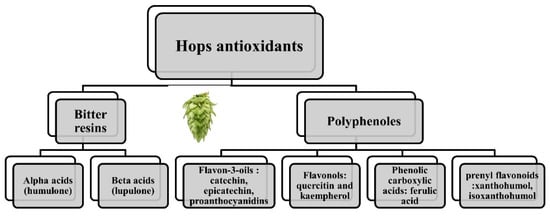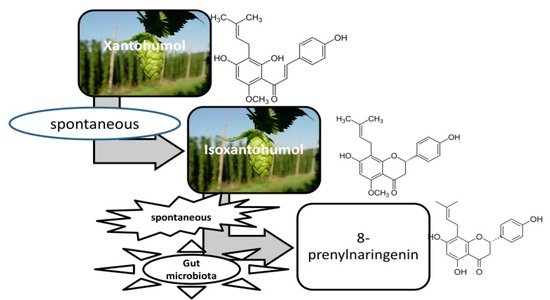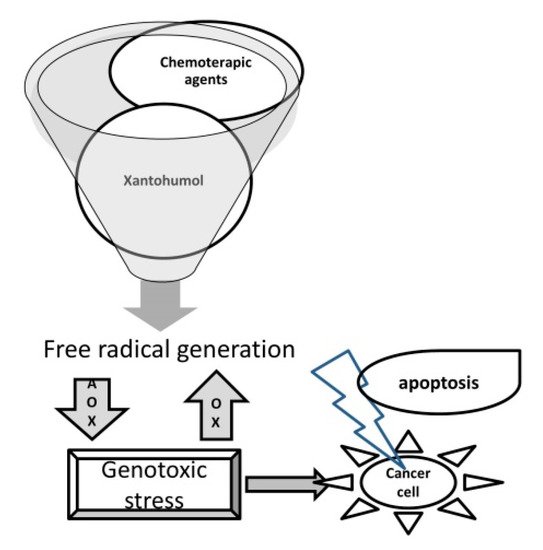You're using an outdated browser. Please upgrade to a modern browser for the best experience.
Please note this is an old version of this entry, which may differ significantly from the current revision.
Hop plant (Humulus lupulus L.) has been used by humans for ages, presumably first as a herbal remedy, then in the manufacturing of different products, from which beer is the most largely consumed. Female hops cones have different useful chemical compounds, an important class being antioxidants, mainly polyphenols.
- hops
- antioxidants
- metabolic syndrome
- bioavailability
1. Introduction
Hops Humulus Lupulus Linnaeus is a plant known and cultivated by humans for a very long time. Early evidence links its origin to ancient China, later found in most temperate areas of the world [1]. Though today we associate hops with beer production, and this was true for centuries, its initial use has been different. Hops were often used as medicinal plants in the popular pharmacopoeia, designed to relieve the symptoms of a large number of health problems [2]. It has been attributed anti-inflammatory and antimicrobial properties, as well as diuretic, digestive, sedative, progestogenic properties, even being considered a cure for insomnia. For this wide range of health benefits, it was regarded as a life prolonging plant [3].
The main component of the hops used today is the cone, the female inflorescence of the plant, but other areas of the hops plant also prove to be useful (the leaves, stems or rhizome). There are several bioactive molecules that underlie the sanogenetic effects of the plant [1,4,5]. For example, in the cone glands, the primary metabolites are the bitter resins and the aromatics. The secondary substances belong to three categories of substances: resins, oils and polyphenols (4–14% dried weight) [6,7] (Figure 1).

Figure 1. Antioxidants in hops.
There are two types of bitter resins: alpha acids (mainly humulone) and beta acids (mainly lupulone). As for polyphenols, they can be classified into: flavonols (quercitin and kaempherol), flavon-3-oils (the main ones being catechin, epicatechin, proanthocyanidins), phenolic carboxylic acids (ferulic acid) and, in lesser quantities, prenyl flavonoids such as xanthohumol (0.1–1% on dry weight) [8,9] and isoxanthohumol. Their very small quantities do not necessary preclude a biological effect. For example, isoxanthohumol is transformed in the intestine into prenylnaringenin, a phytoestrogen uptaken by the intestinal cell. Depending on the individual microbiota, it was estimated that one third of the population could produce high enough levels to reach the threshold for a biological effect [10].
2. Bioavailability of the Active Substances
As for all foods, bioavailability is crucial when evaluating the practical consequences of hops components. Studies show that the bioavailability is rather low [12,13], and ways for increasing it were developed. One alternative is prenylation, which increases the biological activity of dietary flavonoids by enhancing their affinity for estrogen receptors, facilitate the interaction with cellular membranes and proteins. As a consequence, they tend to remain for longer time in certain target cells and have greater antioxidant effect [14]. The bioavailability is increased in the presence of the prenyl group, which decreases the polarity of flavonoids. Degradation of xanthohumol in the intestine is also influenced by the prenyl group. The presence of this group slows down the degradation of xanthohumol [14,15].
The bioavailability of prenylflavonoids is not only influenced by the presence or absence of functional groups. The human microbiota, as stated above, greatly influences the resulting metabolites (Figure 2), which may be of pharmaceutical importance as well. Numerous studies have been performed to identify them, and less to assess their bioavailability.

Figure 2. Transformation of xantohumol in the digestive system.
Depending on the predominant microorganisms in microbiota, the metabolic products may be different, with an activity similar or different to that of the initial substances [16].
Xanthohumol, the main substance studied among the many components of hops, has a low bioavailability to oral administration, which limits its sanogenetic effects [13]. Nookandeh et al. showed that more than 80% of the products of the intestinal degradation of the orally administered xanthohumol to laboratory animals was excreted in feces [17]. Similar results were found by Avula et al. who concluded that most of the administered xanthohumol is excreted in feces in the 24 hours after administration. Studies conducted on Caco-2 cells showed that xanthohumol accumulates in the cytosol, binds to the cellular proteins [18] and even has the ability to insert inside the lipid bilayer of cell membranes, which makes a rapid transmembrane transfer very difficult [19,20,21].
Novak et al. investigated the pharmacokinetics and bioavailability of pure xantohumiol or a hops extract, comparing the oral with the iv routes in rats. There were no differences due to sex, but the oral absorption was very low compared with the iv route. The probability of a hepato-entero-hepatic recirculation of the compounds was also postulated, based on the peaks of plasma levels after ingestion [22].
A blinded randomized study with different doses of xanthohumol given orally showed similarities with the animal experiments. This study highlighted that plasma xanthohumol significantly increases only after more than 60 mg. Two peaks in plasma xanthohumol (as observed in animal experiments), 1 h and 4 h after administration, were observed; the half time was around 20 h [23].
Low bioavailability was noted also for Iso-α-acids (IAA) and the reduced derivates, dihydro-iso-α-acids (DHIAA) and tetrahydro-iso-α-acids (THIAA). However, reduced metabolites had a higher bioavailability [24].
Cattoor et al. also carried out an analysis of the absorption of bitter acids from hops through Caco-2 monolayers. Membrane permeability was higher for alpha than for beta acids. Consequently, oral administration of beta acids had a low absorption, probably limited by the active transporters of P-gp and MRP-2 efflux and by phase II metabolism [25].
As low bioavailability is common to many plant bioactive substances, new forms of administration and new additives are being tested to improve or address this issue in the near future.
3. Hops Antioxidants and Cancer
Hops substances and cancer have been extensively researched during time and from the multitude of components, xanthohumol was frequently under scrutiny.
The substance was discovered in 1957 [33], its properties being brought to light only in the recent decades [34]. After ingestion, xanthohumol undergoes transformations, sometimes resulting in substances with a higher antioxidant power and a wider spectrum of action. It was noticed that xanthohumol is transformed by a non-enzymatic mechanism in isoxanthohumol and enzymatically, in 8 and 6-prenylnaringenin and in desmethylxanthohumol [35,36].
The positive action of xanthohumol in neoplasms was shown for tumors with various localizations, from lung or digestive system (colon, pancreas), to endocrine (thyroid) or genito-urinary (cervical, ovarian), head and neck, skin, malignant melanoma or leukemia [37,38].
The ways in which xanthohumol acts were the subject of a large number of studies are summarized by Jiang et al. in a 2018 article [37].
The action of xanthohumol is probably achieved by the inhibitory action on two signaling pathways with an essential role in maintaining the appearance of malignancy and in achieving metastases: Akt and NF-κB. Xanthohumol induces apoptosis of cancer cells by stimulating pro-apoptotic proteins (Bax, PARP, AIF- caspase-3, -8, -9) and by inhibiting proliferation, achieved by inhibiting Notch1, mTOR, STAT3. Xanthohumol also acts on the migration and invasion of neoplastic cells, probably by inhibiting FAK and MMP-2 expression [37]. Moreover, xanthohumol seems to act synergistically with the usual chemotherapeutic treatments, which is certainly a positive factor because it could theoretically allow for a decrease in the doses administered. Jiang et al. note that xanthohumol influences various proteins that bear upon proliferation, migration, invasion, apoptosis or resistance to many chemotherapeutics in cancer patients, without the exact mechanisms being known at this time.
Girisa et al. conclude that hops have an important anticancer potential, acting by modifying both signaling pathways (Akt, AMPK, ERK, IGFBP2, NF-κB, and STAT3), and by modulating proteins (Notch1, caspases, MMPs, Bcl-2, cyclin D1), oxidative stress markers, miRNAs and tumor suppressor proteins [39].
A very interesting aspect is related to the antioxidant action of xanthohumol. It is known that in the etiology of neoplasms, from cell proliferation to local invasion and metastases, oxidative stress is involved, on the regulation of which many oncological treatments are based. It is just that the accumulation of free radicals is not only a cause, but also a factor that determines the sensitivity to treatment [40], many chemotherapeutic agents acting precisely to stimulate the formation of free radicals in neoplastic cells [41]. In this context, it was shown that, although it has a high antioxidant power, xanthohumol also induces an important production of free radicals in various neoplastic cell lines, causing their apoptosis [42,43,44] (Figure 3).

Figure 3. The oxidative stress: a common mechanism of action of xantohumol and chemotherapeutics on cancer cells.
Wei et al. concluded that xanthohumol also causes an imbalance between intracellular antioxidants, such as SOD, and the production of free radicals, which potentiates xanthohumol’s apoptotic and antimetastatic, antiproliferative action. High levels of free radicals, which are easily reached by depressing cellular antioxidant systems, reduce NF-κB activity, leading to cell death [45].
Xanthohumol stimulated the anticancer actions of high ROS by the NF-κB signaling pathway. Future studies should show the extent to which classical neoplastic treatments could benefit from the associated administration of xanthohumol products in clinical practice.
An important activity of xanthohumol is related to metastasis formation. After xanthohumol proved to be effective in pulmonary adenocarcinoma, Sławińska-Brych et al. also confirmed its effectiveness in inhibiting metastatic processes. The mechanisms involved in the antiinvasive action appear to be the inhibition of the ERK/MAPK pathway and the suppression of FAK and PI3/AKT signaling [46].
Other mechanisms seem to be common to xanthohumol, iso-xanthohumol and 8-prenylnaringenin, as antioxidant and anticancer agents. They refer to the action on Aldose reductase (AKR1B1) and a counterpart, AKR1B10. Both substances are overexpressed in neoplasms with various localizations, from lung and prostate, to breast. This makes them potential treatment targets. Seliger et al. showed that xanthohumol, iso-xanthohumol and 8-prenylnaringenin substantially and indiscriminately inhibit B1 and B10 [47].
Recently, new studies reveal the action of xanthohumol in neoplasms with localizations that had not been previously followed. One of these is the stomach. Gastric cancer is a form of cancer with a high incidence and a very poor prognosis. Wei et al.’s 2018 study confirms that xanthohumol has a deleterious effect on gastric cancer cells, but not on healthy gastric cells. Xanthohumol inhibits proliferation, induces apoptosis and reduces cancer cell metastases, most likely by free radical overproduction [44].
An interesting subject could be the effects of xanthohumol in colorectal cancer, from the perspective of the previously mentioned reduced bioavailability, which leaves most of the ingested substance in contact with the terminal areas of the digestive system. Scagliarini et al. show that xanthohumol, applied on cancer cell cultures, can activate cell cycle disruptions, even in non-toxic concentrations, by reducing cyclins A and B and concomitantly increasing cyclin E [48]. Apoptosis was found in some of the most resistant cell lines 48 h after the debut of treatment with xanthohimol, and their sensitization to the action of usual chemotherapeutics was also noticed. Xanthumol activated p53 and p21, which recommends the substance as a pre-treatment of chemotherapy, not only to increase its effectiveness, but also to reduce the therapeutical dose and, consequently, the side effects. Taking into account the conclusions of Ambroz’s study [49], which reports antagonistic effects on concomitant administration of xanthohumol/chemotherapy, it was concluded that administration should be staged, in order to avoid decreasing the efficacy of the chemotherapeutics. It should be noted that other studies confirmed the cytotoxic action of other prenylflavonoids in hops on colonic proliferative cells, but xanthohumol had the most active contribution [50].
Harish et al. [12] summarized the mechanisms in which xanthohumol exerts its antineoplastic action in vitro, as follows: induction or inhibition of apoptosis, modulator of oncogenic signaling pathways, the free radical formation, and the ERK1/2, NF-κB, and Akt signals. The major courses of action differ after the location of the cancer. For example, in breast cancer it acts by decreasing the expression of Notch1, survivin and Ki-67, and by potentiating the expression of capsase 3, simultaneously inhibiting STAT3 and MDR 1. Another neoplastic localization in which xanthohumol was effective is the prostate, where it induced apoptosis via TNF-Related Apoptosis Inducing Ligand as well as by depolarizing mitochondria by activating procaspases 3, 8 and 9. One has to take into consideration difficulty of in vivo assessments, especially due to the reduced bioavailability of oral administration.
Recently, minor components of the antioxidant profile of hops were highlighted and investigated, having synergistic effects and being sometimes more active than xanthohumol. One of the minor natural compounds is xanthohumol C, which inhibits mammary neoplastic cell lines more intensely than xanthohumol or xanthumol-enriched hops extract. The mechanism of action of xanthohumol C appears to be different from that of xanthohumol; it seems to be involved in endoplasmic reticulum stress and in altering the adhesion of cells to each other [51]. Xanthohumol C is a chalcone with various types of action, including cytotoxic [52] and antioxidant [7,53] manifested in the context of neoplasms. Xanthohumol C was described by Stevens et al. [54] and due to difficulties in obtaining pure substances and, consequently, to the interference of other minor compounds, they noticed a lower antiproliferative action in certain neoplastic cell lines (breast, colon, prostate) than the one of xanthohumol [52].
Other hops substances were studied in relation to neoplasms, especially the bitter acids. Humulon shows anticancer and anti-inflammatory effects on skin cancer [55]. Lupulon activates apoptotic pathways including apoptotic TRAIL-receptors, in human cancer colon cells and in the equivalent metastatic cells, even in TRAIL resistant cancer cells [56,57]. Both substances show promising effects for cancer prophylaxis and treatment.
This entry is adapted from the peer-reviewed paper 10.3390/antiox11020241
This entry is offline, you can click here to edit this entry!
